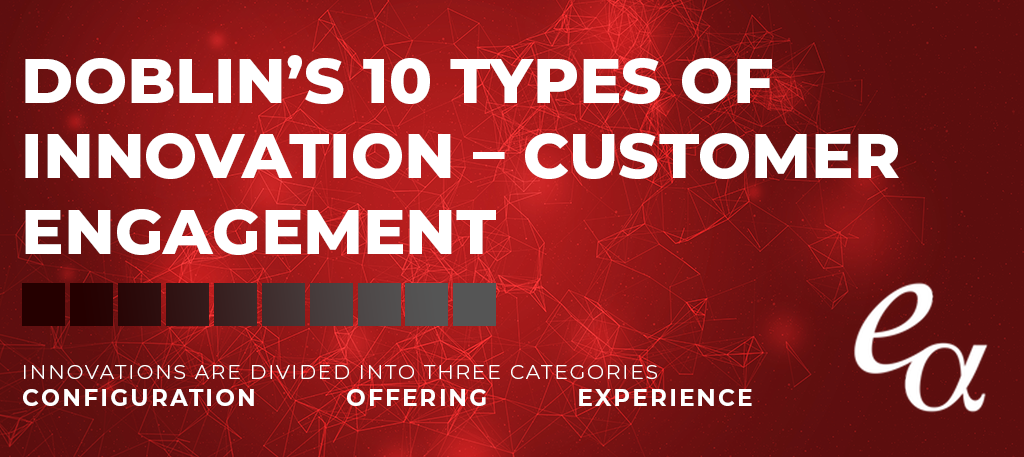Intro
In this series of posts, we will be inspecting Doblin’s 10 Types of Innovation, a popular framework for analyzing innovations in business developed by the Doblin Innovation Firm in Chicago. Innovations are divided into three categories: configuration, offering, and experience. Configuration focuses on the innermost workings of an enterprise and its business system, offering focuses on an enterprise’s core product or service, and experience focuses on customer-facing elements. In this post, we will analyze the final block in experience, customer engagement innovation.
Definition
Customer Engagement Innovation is essentially about how you foster compelling interactions. Doblin defines customer engagement innovation as:
“Customer Engagement innovations are all about understanding the deep-seated aspirations of customers and users, and using those insights to develop meaningful connections between them and your company. Great Customer Engagement innovations provide broad avenues for exploration, and help people find ways to make parts of their lives more memorable, fulfilling, delightful — even magical.”
Customer engagement innovations are all about finding more efficient and creative ways to interact with your customers and how to elevate their thinking about your product or service so they can connect with it better. Customer engagement innovation often overlaps with or is embedded within other innovation types, like brand or service, and can be difficult to distinguish. It is important to remember that customer engagement innovation deals specifically with the point of interactions and how they connect with consumers.
Examples
Since there are countless ways for companies to interact with customers, customer engagement innovation takes many forms. Increasingly, more and more customer engagement innovations are occurring digitally, especially on the Internet, but a fair amount are still rooted in physical engagements. A few types of customer engagement innovation include:
- Social Media – utilizing social media to better engage with audiences
- Community – creating opportunities for customers to foster connections with one another and build a sense of belonging
- Experience Automation – removing a repetitive task from a customer’s process flow
- Experience Simplification – transforming a complex experience into something simple and delightful
- Mastery – help customers deepen their skills or knowledge in a given subject through your products or experiences you provide
- Partner Relationship – treating a relationship with a customer as one where both parties grow and learn together
- Intuitive Packaging – simplifying the unboxing process in elegant ways to elevate the customer experience
For this blog post, we will focus on examples regarding experience simplification, community, and mastery.
Experience Simplification Examples
These customer engagement innovations take user experiences that are complicated and make them more intuitive and easier for consumers.
Mint is a personal finance management website and mobile app that was acquired by Intuit in 2009. Mint understood that personal financial management is unenjoyable and full of drudgery, so they transformed the experience of money management by simplifying tasks like automatically updating transaction history, automatically tagging and categorizing purchases, and suggestions for saving and budgeting. This simplification of the experience has made Mint hugely popular — it is the all-time most downloaded personal finance app.
Nintendo is a Japanese multinational consumer electronics and video game company. The Nintendo Wii was a revolutionary game console that utilized accelerometers in its controllers to enable motion capture, expanding consumer interaction from the screen to the physical environment around the player. This greatly lowered the barrier of entry for casual gamers who are inept with normal controllers, and helped the Wii become the best-selling console of its generation.
Uber Technologies is an American technology company most famous for its ride-share app. Before Uber, hailing a ride was a complicated process, requiring either calling a taxi or rideshare or coordinating with friends to see who would drive. By distilling that process into a simple app where you can summon a ride basically with the touch of a button, Uber disrupted the entire transportation industry and has become one of the most influential companies of the last ten years.
Community Examples
These customer engagement innovations build a sense of belonging for a company’s customers, allow them to foster connections with one another, or both.
Blizzard Entertainment is an American video game developer and publisher most famous for creating World of Warcraft. Like many MMORPGs (Massively Multiplayer Online Role Playing Games), World of Warcraft actively encourages users to engage with each other by incentivizing teaming up with higher rewards. Because of Blizzard’s intimate understanding of what makes users dedicate hundreds of hours into a game, they have been hugely successful, with World of Warcraft alone reaching 12 million subscribers at its peak in 2010.
The Walt Disney Company is an American diversified multinational mass media and entertainment conglomerate. Unlike many entertainment companies, Disney’s unique brand has led to it having a dedicated fanbase whose participation Disney actively encourages through unofficial fan clubs and official ones like D23. These Disney fans are united through their shared love of all things Disney as well as the most potent intangible asset that Disney’s offerings give them — a feeling of magic.
Recreational Equipment Inc. is an American retail and outdoor recreation services corporation that sells sporting goods, camping gear, travel equipment, and clothing. REI is dedicated to creating a community of people with shared values and a love of the outdoors through their membership program, which offers special perks and an exclusive online forum for members to have conversations and share inspiration. They even went so far as to close their doors on Black Friday, the busiest shopping day of the year, to encourage their customers to get outdoors, further reinforcing their commitment to adventure.
Peloton Interactive is an American exercise equipment and media company. Peloton sells workout equipment with built-in screens and subscriptions to live and on-demand classes, simulating a real-life gym environment in the comfort of a user’s own home. Peloton’s approach to community is unique in that it leverages technology into creating a purely virtual community that nonetheless helps subscribers get over the difficulty of trying to motivate themselves when working out alone.
Mastery Examples
These customer engagement innovations help customers develop their skills or knowledge in a company’s offerings through services or experiences.
Apple is an American multinational technology company that designs and sells consumer electronics, computer software, and online services. Not only does Apple provide streamlined technical support at their retail stores through their Genius Bar, they also offer courses and classes to help customers learn their products and associated software (like Adobe Photoshop) better. By offering these classes, Apple is able to further lock customers into their ecosystem by engaging all of their customer types, from artists to app developers.
Sephora is a French multinational retailer of personal care and beauty products that features nearly 3,000 brands along with its own private label Sephora Collection. Sephora offers various classes through their stores, such as beauty classes taught by experts for customers who want to improve their makeup or skincare skills or confidence classes that help customers who are facing major life transitions. Through these auxiliary offerings, customers are engaged in a way that makes them see Sephora not just as a brand, but a lifestyle.
Established by renowned architect Fu-Tung Cheng in 2004, Concrete Exchange is a combined training/product company for concrete countertops. Concrete Exchange not only supplies contractors, designers, and other customers with the necessary components, they also educate customers with the knowledge they need to work with concrete. Because concrete was not a popular material for countertops until Cheng, this was a necessary service to provide, and it has paid off — concrete countertops are now widely employed in thousands of homes.
Techniques to Develop Customer Engagement Innovation
Customer engagement innovation, like many other innovations, starts with identifying the needs and desires of your customers and understanding how to leverage them. What are your customer’s aspirations? How do you interact with your customers and delight them with compelling experiences? How can you build a connection between your customer and your offering? How can you differentiate between the engagement techniques of your competitors? Two key themes to keep in mind when developing customer engagement is authenticity and knowledge. Customers greatly desire authenticity, but true authenticity can be scarce. While customers are savvy enough to sense fake authenticity a mile away, truly authentic interactions along with an exchanging of information and ideas will always be valuable to a brand.
Many companies turn to technology to help them develop these customer engagements. In today’s fast-paced environment, companies have been focusing on real-time experience initiatives based on highly targeted and “in the moment” interactions with individual customers. Because so many of these efforts are data-focused, they require a vast amount of resources like cloud systems, data warehouses, third-party and partner data, integrations into other platforms and devices, and intelligent analysis tools. Because of the vast amount of data that needs to be processed, some companies go so far as to hire outside data scientists or even create a role within the company to oversee all insights and apply them to customer engagement, called Chief Marketing Technologists (CMT).
While utilizing data to unlock insights into individual customers is certainly a powerful tool, it can be prohibitively expensive, especially to smaller businesses. It also can be highly competitive, as more and more companies are vying for attention through a few key channel points, like social media. As a result, it’s important to note that technology is simply a tool and useless without the proper strategy. No technology is good enough to guarantee customer loyalty or increase customer retention. Staying technology agnostic and focusing on the fundamentals of understanding your customer will always lead you in the right direction. What’s most important is to build a customer engagement ecosystem that includes all brand actions, other actors, customer brand experience, shopping behaviors, brand consumption, and brand-dialog behaviors.
Impact
Great customer engagement innovations are mutually beneficial for both companies and their customers. For customers, engagement innovations enhance the overall experience with a product or service, taking something mundane and making it magical or taking an everyday obligation and making it fulfilling. For companies, customer relationship management (CRM) and customer engagement innovation lead to competitive advantage and differentiation, which have a direct effect on a company’s performance and profitability. In many cases, a company’s customer experience becomes their brand, and with a fantastic customer experience comes customer loyalty.
Conclusion
Customer engagement innovation is an all-encompassing and broad type of innovation for companies to explore new ways to build relationships with their customers by elevating their experiences. While many companies are investing exorbitant sums of money into data collection and analysis, that is not the only way companies can innovate their engagement. In fact, adding a more human element to your engagement could be what sets you apart from your competitors. At the end of the day, the best customer engagement innovations focus on the deepest needs and desires of their customers and turn them into magical experiences.
We hope that this series of posts on the Ten Types of Innovation will help inspire you as you go forward on your innovation journey. Just remember — there is no limits or confines to innovation, and the next great innovation is out there waiting to be found.




